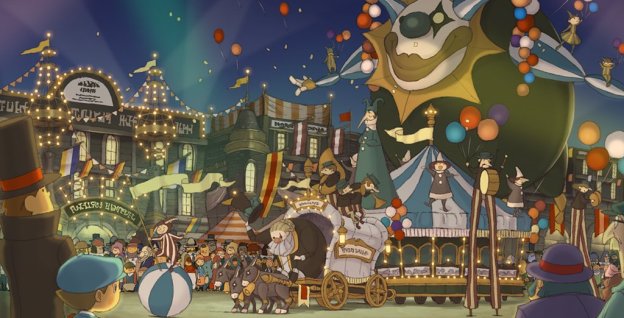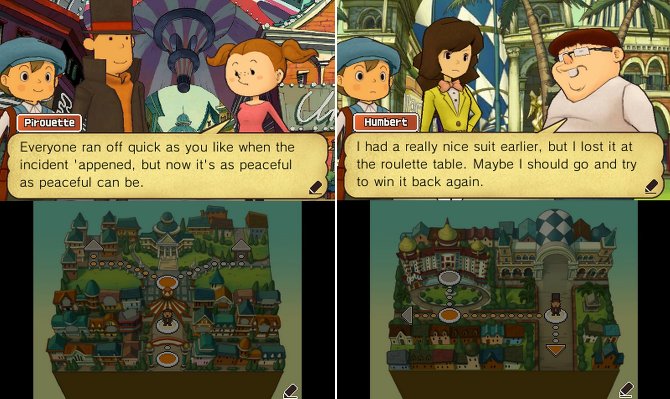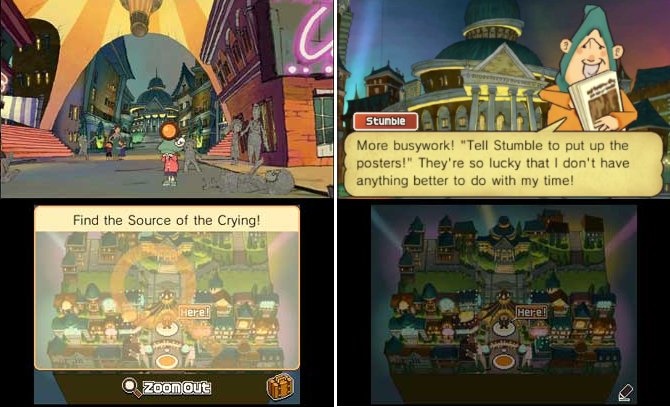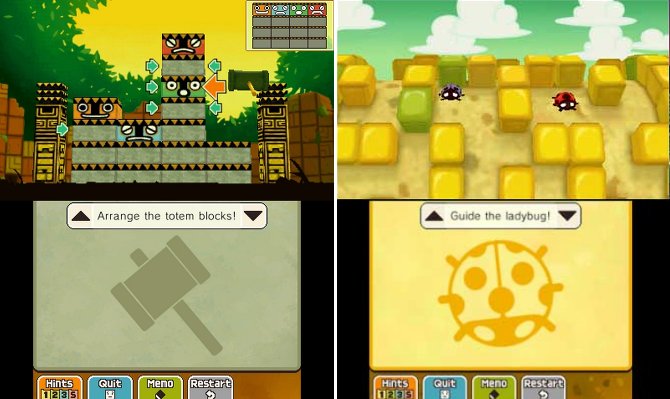Exceptional art direction; crisp, clear audio; strong voice talent; 3D a boon to the series; gripping plot in the longest entry yet.
Teen drama in flashbacks is a bit much; a handful of puzzles are duds; most British accents are put on.
As an annual series, the Professor Layton games run the risk of becoming stale. Indeed, last year’s The Last Specter, despite its introduction of amazing characters in its telling of the origins of Layton and Luke’s relationship, was treading on especially dangerous ground. While still a good game in its own right (much like the fact that there is no such thing as a bad Legend of Zelda entry), its deus ex machina reveals, retreaded puzzles, and bizarre pacing took the wind out of the series’ sails, especially after the masterpiece that was Unwound Future.
It’s safe to say, however, that Professor Layton and the Miracle Mask brings all of that magic back to the fore.
For the puzzled among us, the Professor Layton titles are adventure games set in an alternate-universe Britain that is a mishmash of anachronisms, where brainteasers are integrated fully into society– they serve to break the ice, determine friendship and trust, and are generally seen as this reality’s version of favors, a form of social currency. The games themselves follow the good professor and his companions on their “Laytonesque” adventures– a concerned citizen writes to him of their small town’s unusual troubles, and Hershel Layton, a true gentleman, gets to the bottom of the mystery.

Professor Layton and the Miracle Mask is the fifth game in the series, the second in the prequel trilogy, and the first on 3DS. A mysterious figure known as the Masked Gentleman is terrorizing Monte D’Or, a gambling city out in the heart of the desert, performing seemingly inexplicable “Dark Miracles”– paintings in the museum come to life, and tourists turn into horses or become petrified or disappear into the night sky. Layton is called to the town by Angela Ledore, a childhood friend (Layton, in a fit of contemporaneousness, calls their relationship “complicated”) to investigate, and the professor, and we, oblige.
And what a case it is. The Layton titles comprise what are arguably the most beautiful games on the DS, and this visual excellence is continued on the current Nintendo handheld. The exquisite Ghibli-inspired animation is only enhanced by the subtle addition of depth, and the lovingly crafted 2D character art has been replaced with lovingly crafted 3D models that, through CG wizardry, preserve much of the allure of the original illustrations. What little charm is lost is offset admirably by the animations that show off their personality– the returning Scotland Yard inspector’s “Grosky OUT!” dash more than makes up for that horrifying chest hair.

The graphics make the most out of the hardware. Due to its greater resolution, all the action takes place on the top screen, in contrast to the touch screen-centric DS titles, bringing a few changes to the gameplay. Navigation is conducted with the touch screen, tapping on the next destination on the map. Investigation has been separated from movement, requiring a second tap to activate. Players must now use the touch screen as a mousepad of sorts, moving a magnifying glass around the top screen to examine the environments that are more detailed than ever. These setpieces are fully interactive this time around in a seamless mix of 3D and 2D models, akin to a diorama or a pop-up book in the trademark Layton aesthetic. The effect is stunning in 3D, with background and foreground clearly delineated, which helps in filtering out the crowds (!) from the hailable NPCs.
The larger 3DS top screen eases the pixel-hunting that is a series standby, and the magnifying glass system further lightens that burden– if any background element can be interacted with, whether it hides a Hint Coin, a Collection piece, or a hidden puzzle, the lens turns orange and a little chime serves as an alert, a welcome refinement to the mad random tapping on the DS titles (though series veterans will instinctively know just which balustrade hides that elusive bonus). The usual excellent audio is enhanced by both the increased space on the 3DS game cards and the system’s capabilities– listen to Professor Layton’s theme at the first opportunity.

While the game uses 3D well in the overworld, with ghosting only visible in strong external lighting, thankfully, the game does not include any puzzles that require it (similar to the optical illusions in Super Mario 3D Land), allowing more people to play. The puzzles are the usual stimulating fare, testing your logic, reading comprehension, mathematics, inductive reasoning, spatial awareness and observational skills, to name a few. The “divide the board” puzzles, a personal favorite, also return, and I am pleased to report that sliding block puzzles, that bane of lesser mortals, are few and far between. While only one puzzle type, involving the gyroscope, wouldn’t have worked on the DS, new puzzle forms, such as those involving arranging totem poles, ladybugs finding each other in a corn labyrinth (a maize maze, if you will), and flipping pizza slices look great on the 3DS screen.
More of the puzzles are more contextual than before, with Layton helping a little girl find her mother and untangling a familiar-looking clown from his balloons, though the always-hilarious “This reminds me of a puzzle!” scenarios make a lovable return. The reduction in puzzle count (135 in the story, 15 in the Bonuses) is compensated for by the greater variety and the addition of daily downloadable puzzles for an entire year after release, bringing the total count to a whopping 515. Luckily, these are retroactive, which means one needn’t go online every day to get them– I first connected to the adorable client after clearing the story, and netted 15 puzzles at once.

Layton games are as much about the story as they are the puzzles, and this one does not disappoint, being only second to Unwound Future in terms of emotional weight. In the quest to foil the Masked Gentleman, themes such as capitalism and faithfulness are explored, although a few of the final revelations, especially involving one of the female leads, are rather distasteful in their implications, counteracting much of the progress made with Emmy Altava’s debut in the last game; the plucky, capable assistant continues to be invaluable to the professor, however.
Speaking of the professor, we learn even more about his past (and meet his Ma and Pa Kent-like parents!) via a series of interesting, though demystifying, playable flashbacks to his time in high school, through which we learn of the source of his love for puzzles, passion for archaeology, and swordfighting prowess. These run parallel to the present-day plot, and allow the intricate story to unfold. While much of the twists can be seen coming a mile away, Miracle Mask focuses on the characters and their conflicts themselves, creating a narrative that spans nearly two decades. This continuity extends to the entirety of the prequel trilogy, with connected arcs stemming from Professor Layton’s archaeological endeavors, as well as numerous callbacks to past games.

The extra content does not seem like an afterthought. The minigames are particularly compelling, involving a robot obstacle course, a cute bunny who wants to return to the circus theatre, and, believe it or not, planning your moves ahead in Uno in a shopkeeping association game. An overworld minigame where Luke, Emmy, and Layton ride their respective horses through Monte D’Or is thrilling, but marred by finicky all-touch controls. Perhaps the best minigame is the final act in the flashback sequences, which is too good to spoil here; let’s just say that it’s the best integration of puzzles and gameplay yet and has the young Hershel getting a taste for archaeology, providing foreshadowing for the badass he will become in future.
Professor Layton and the Miracle Mask is a marvelous return to form, expertly adapting to the 3DS all of the strengths of the franchise– compelling characters, top-notch production values, and the all-important puzzle– into a cohesive game. We love the thrill of a good solution, and this latest entry to the series provides them in spades.




 ShareThis
ShareThis






